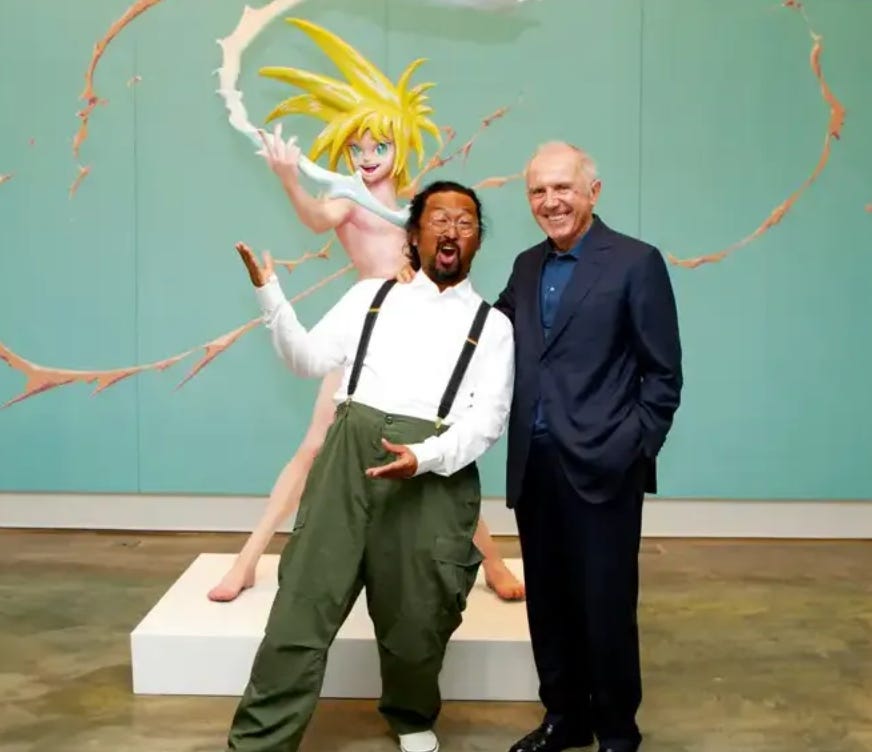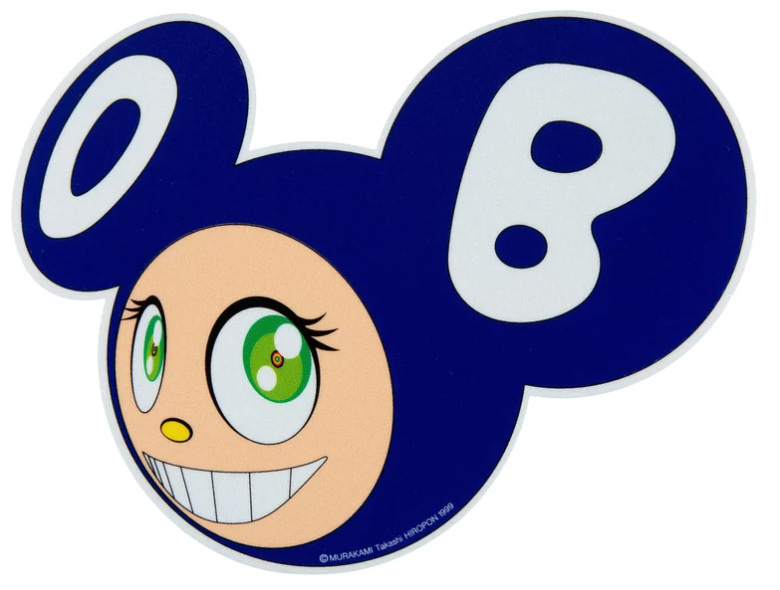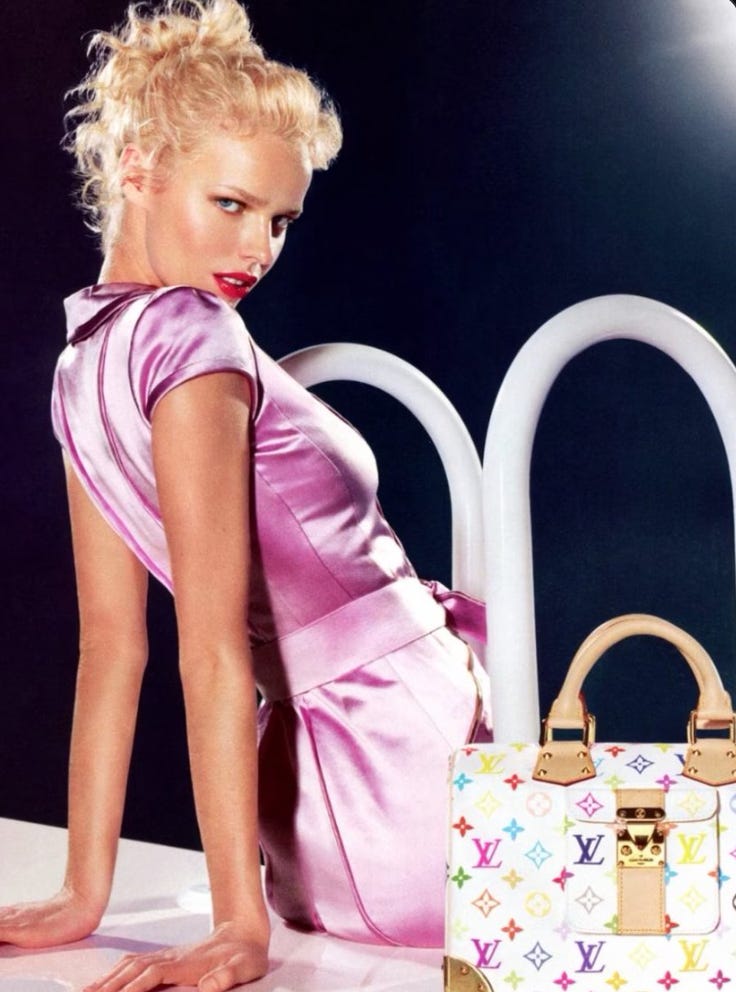There's an artist whose collections grow in value by an average of 10% annually,and that artist..
Murakami Takashi
Hi, there. Welcome to Notsimple!
Today, we will learn about an artist whose value grows by an average of 10% each year. This is a remarkable figure for an artist. Let's examine how he has successfully managed to grow his value while operating his work or business.
There's an artist whose collections grow in value by an average of 10% annually, and that artist: Murakami Takashi.
Even if you're unfamiliar with Murakami Takashi, you've likely seen his famous flower paintings.
He has become a massive brand that appeals to a wide range of patrons, from college students to affluent collectors. He appeals to a wide range of patrons. Let's explore why this is possible.
Not Simple: As an entrepreneur, what strategy did Murakami Takashi employ?
For artists, the choice between commercialism and artistic integrity is never easy. Opting for the former might lead to accusations of turncoat while choosing the latter could make sustaining their work difficult.
In this regard, Murakami Takashi decisively chose commercialism, framing the latter as his brand strategy.
In 2008, a record sale of $15.1 million. Murakami Takashi achieved his highest-priced sale in May 2008 when his work "My Lonesome Cowboy," inspired by Andy Warhol films, sold for $15.1 million at Sotheby's Contemporary Art Evening Auction in New York.
Building economies of scale
Murakami's sustained popularity and influence drive his market presence in the secondary market. His prints consistently retain high value.
He creates everything from paintings to sculptures, videos, t-shirts, keychains, mouse pads, dolls, phone cases, and even Louis Vuitton handbags. In other words, Murakami's products cater to all price ranges.
Murakami Takashi aligns closer to a corporate strategy than an artist's approach. Murakami's factory produces inexpensive trinkets alongside multimillion-dollar artworks.his approach breaks the elitist facade of the art world while maintaining value and achieving economic profitability.
The extensive accessibility of his brand strategy enables anyone to own Murakami's work.
So how was Murakami Takashi able to run his vast empire so well?
Looking closer, how was he able to maintain value while absorbing a large supply of products?
Strengthening brand identity through characters:
Murakami Takashi maximizes product value beyond scarcity with artistic messaging as a brand strategy. In the 1980s, the rapid rise of manga and animation began in Japanese culture and spread to the United States.
Murakami studied characters like Mickey Mouse and Hello Kitty for their universal appeal and commercial secrets. His efforts materialized in Murakami's most famous and enduring character, Mr. DOB. This marked the beginning of the his character industry.
Operating the 'factory' of a brand with exactly corporate logic:
Rather than solely an artist, Murakami efficiently operates his business as a manager. As the CEO of Kaikai Kiki, Murakami leads an art production company known as Hiropon Factory.
There is not just an artist's studio. There is :
-Accountants
-Public relations officers
-Managers
-With an IT
-administered administrative system
-Employees write daily reports on their work
-A process of integrating these reports into emails.
He manages Hiropon Factory with corporate efficiency, integrating IT systems and daily reporting inspired by Bill Gates's "The Speed of Thought."
Mass production through characters and repetitive motifs:
Murakami's artworks feature strong character identities and repetitive motifs, efficiently produced at Hiropon Factory with advanced technology.
His artworks feature repetitive motifs such as eyeballs and flowers. This led the factory to maintain an IT archive capable of inserting files he's working on.
His works (or products) rely heavily on the highly efficient operations of Hiropon Factory for mass production. Employing dozens of assistants to perform specialized tasks, they operate technology realistically and labor-savingly.
Maintaining Murakami's factory identity as an brand:
Beyond mass production, Kaikai Kiki supports artists through exhibitions, artist promotions, and collaborative marketing, maintaining artistic integrity and broad appeal.
Murakami's factory doesn't stop at simply mass-producing items.
Under the vision of making art and commerce smoothly integrated, Kaikai Kiki supports various artists. They develop numerous exhibitions together, promote new artists, operate art fairs, and conduct marketing together.
A character of a company showing meaningful brand movements leads to the emergence of mass demand. Even if the supply of a product increases and the scarcity falls, the public wants it to appeal the message.
So Murakami's integration of art and commerce fosters sustained brand growth and popular demand.
Murakami introduced the Superflat Theory, blurring the distinction between high and low art. This approach justified mass-produced items while maintaining brand identity. From collectors to students, everyone desires a Murakami Product under his savvy business strategy.
Murakami creates both million-dollar sculptures and smaller decorative pieces, all based on similar themes This approach allows his factory to produce products across all price ranges, justifying increased supply while maintaining brand identity. From affluent collectors to college students and even elementary schoolers, everyone desires a Murakami Product under his savvy business strategy.
Leading the charge in art and fashion collaborations:
Murakami is a pioneer in current art trends, although this fact is not widely recognized.
The collaboration between Louis Vuitton and Murakami was a symbolic attempt to bridge the gap between the art world and fashion brands, which had previously been avoided.
Despite criticism from art purists, it helped usher in an era where artists began collaborating with fashion houses.
This collaboration not only appealed to the high-fashion audience but also showcased the allure of Murakami's products to a broader audience.
Collaborations from Kanye West to Billie Eilish:
In 2007, Murakami provided the cover artwork for rapper Kanye West's album "Graduation" and directed an animated music video for West's song "Good Morning."
His collaborations continued in 2019 with Billie Eilish, where he directed one of the official music videos for her song "You Should See Me in a Crown," using his distinctive animation style.
These collaborations firmly established Murakami as a brand appealing to contemporary American pop culture, shedding its old-world exclusivity for a hip, desirable brand accessible to all.
a collaboration can be a double-edged sword. It enhances a brand's strength and expands its reach, but risks diluting its identity if not managed carefully.
The collaboration with Louis Vuitton
In 2002, his collaboration with Louis Vuitton, integrating art into handbags and bridging the gap between high art and commercialism, marked a pivotal moment that propelled him to widespread recognition, both domestically in Japan.
As we wrap up this week's newsletter, let's draw inspiration from an unexpected source: the art world. Specifically, the business acumen of Murakami Takashi, a true titan of contemporary art.
Murakami's journey reminds us that success often comes from unexpected directions. Despite his early works in Japan focusing on social critique and satire, it was his entrepreneurial spirit that truly catapulted him to global fame. His story teaches us a valuable lesson: sometimes, the path to success isn't a straight line, but a series of strategic pivots.
But perhaps the most intriguing aspect of Murakami's strategy is how he's maintained value in a world obsessed with scarcity. In our fast-paced business environment, where products can quickly lose their unique edge, Murakami's approach offers food for thought. He's masterfully used artistic messaging as a brand strategy, maximizing commerciality without sacrificing integrity.
How can you infuse your brand with a unique message that transcends the typical constraints of supply and demand? How can you create value that persists, even as your product becomes more widely available?
Remember, in business as in art, true innovation often comes from blending seemingly disparate elements. Murakami's success lies in his ability to merge artistic vision with commercial savvy. What unexpected combinations might lead to your next breakthrough?
P.S. We'd love to hear your thoughts! What unexpected sources have inspired your business strategies? Share with us, and you might be featured in our next issue!
Thanks for reading, Have a great day, y’all.
We’ll be back in your inbox on Thursday.








